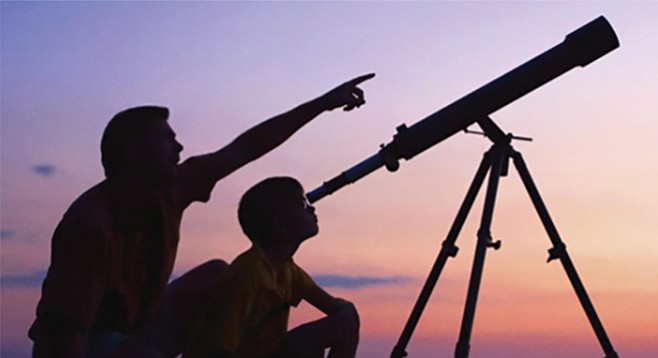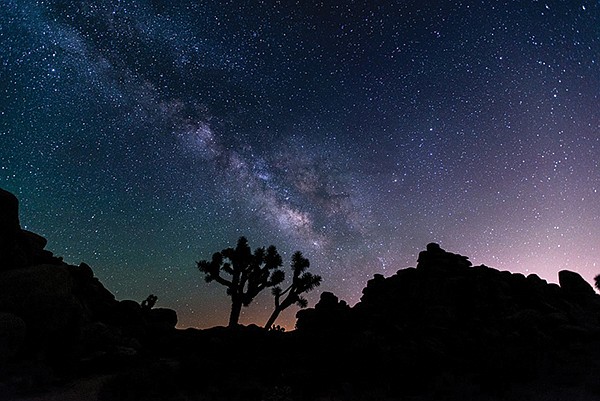 Facebook
Facebook
 X
X
 Instagram
Instagram
 TikTok
TikTok
 Youtube
Youtube

‘I’m tired of you staring at screens all day and all night,” I said to my late-summer teen. “In ancient times, they stared at the night sky.”

“That’s because they didn’t have anything else to look at,” he quipped back.
“Yeah,” I answered, “but unlike you, they learned a thing or two. The internet is just information. They understood the world. You’re going stargazing.”
Ironically, I’ll be starting with a screen. But at least it will be domed, like the vault of the heavens in Greek mythology. Baby steps. The Sky Tonight is a monthly, astronomer-led planetarium show held at the Fleet Science Center in Balboa Park. Shows are held the first Wednesday of each month at 7 pm and 8:15 pm. During the upcoming show on September 5, Dr. Lisa Will will discuss what to look for in the sky during the coming weeks. After the show, the San Diego Astronomy Association will set up several telescopes for participant use outside on the Prado. Group members will even assist in finding specific heavenly bodies. Tickets are $19.95 for adults, $17.75 for juniors.
Then, if I’ve got his attention: a Mom & Me getaway. Observer Inn in Julian offers a 4.5-acre retreat. Guests at the B&B get a discounted rate on the Inn’s Sky Tour ($30 for the public, reservations required), as well as access to the private observatory. The tour begins with a laser-guided informational session, during which an astronomer will point out prominent stars and constellations, followed by a brief explanation of a telescope’s workings. We can look forward (skies depending) to seeing open star clusters or planetary nebula.
The Astronomy Association has other plans for September. On Friday, September 7, they will host a star party at Mission Trails Regional Park, in the Kumeyaay Lake campground on Two Fathers Junipero Serra trail. (They set up a desk in the day-use parking lot, just to the right after you enter the campground.) This event reoccurs every first Friday. And up in North County, you can attend stargazing events at Stonebridge Mission Trails Regional Park in Scripps Ranch. That event is on the 3rd Friday of every month. (Again, the setup is just inside the gate for the day use parking lot.) Both events start at sunset and are free.
Further, on the second Saturday of every month, the Association holds an Oak Oasis Party at 12620 Wildcat Canyon Road in Lakeside. This event starts with a twilight hike (arrival at sunset). Afterward, back at the campground, they start in with telescope time. Rangers are on hand to point out planets and constellations, and to teach basic astronomical concepts. Association members will tell constellation stories — the mythology behind the stars. Plus, there are campfires, s’mores, and hot cocoa. The event is free, but you can reserve a campsite ($24) by calling DPR reservations at 858-565-3600 or the Ranger Station at 619-561-0580.
If he takes to all those, I’ll get him a basic Association membership. For $35 a year, he gets access to their library, periodic training classes, and even a loaner telescope. A full $60 membership includes access to the Tierra Del Sol dark sky observing site. There, members can have private pads where they can set up their own telescopes.
Another item on the agenda will be a visit to the Palomar Observatory on Mount Palomar, home to the 200-inch Hale Telescope. Guided tours of the facility are Saturday and Sunday, April through October ($5 adults, $3 children). Tickets are limited, and first-come/first-serve. Amateur astronomers can of course bring their own telescopes and enjoy the mountain’s spectacular views of the night sky. An Explore the Stars program runs from April to October in the Palomar Observatory campground. The program features hikes and a Saturday star talk at the campground amphitheater at dusk. (Check website for more info.)
Finally, if he’s hooked, I’ll look into a beginner telescope. Rod at Oceanside Photo and Telescope says, “We have telescopes from beginner to advanced. For a beginning teen, I would recommend the Celestron Power Seeker 114 ($129.95). It has enough aperture and light-gathering ability to get you good views of the rings around Saturn and the quad belts of Jupiter. It comes with a stand and a manual, and we’re happy to show you all the features.”


‘I’m tired of you staring at screens all day and all night,” I said to my late-summer teen. “In ancient times, they stared at the night sky.”

“That’s because they didn’t have anything else to look at,” he quipped back.
“Yeah,” I answered, “but unlike you, they learned a thing or two. The internet is just information. They understood the world. You’re going stargazing.”
Ironically, I’ll be starting with a screen. But at least it will be domed, like the vault of the heavens in Greek mythology. Baby steps. The Sky Tonight is a monthly, astronomer-led planetarium show held at the Fleet Science Center in Balboa Park. Shows are held the first Wednesday of each month at 7 pm and 8:15 pm. During the upcoming show on September 5, Dr. Lisa Will will discuss what to look for in the sky during the coming weeks. After the show, the San Diego Astronomy Association will set up several telescopes for participant use outside on the Prado. Group members will even assist in finding specific heavenly bodies. Tickets are $19.95 for adults, $17.75 for juniors.
Then, if I’ve got his attention: a Mom & Me getaway. Observer Inn in Julian offers a 4.5-acre retreat. Guests at the B&B get a discounted rate on the Inn’s Sky Tour ($30 for the public, reservations required), as well as access to the private observatory. The tour begins with a laser-guided informational session, during which an astronomer will point out prominent stars and constellations, followed by a brief explanation of a telescope’s workings. We can look forward (skies depending) to seeing open star clusters or planetary nebula.
The Astronomy Association has other plans for September. On Friday, September 7, they will host a star party at Mission Trails Regional Park, in the Kumeyaay Lake campground on Two Fathers Junipero Serra trail. (They set up a desk in the day-use parking lot, just to the right after you enter the campground.) This event reoccurs every first Friday. And up in North County, you can attend stargazing events at Stonebridge Mission Trails Regional Park in Scripps Ranch. That event is on the 3rd Friday of every month. (Again, the setup is just inside the gate for the day use parking lot.) Both events start at sunset and are free.
Further, on the second Saturday of every month, the Association holds an Oak Oasis Party at 12620 Wildcat Canyon Road in Lakeside. This event starts with a twilight hike (arrival at sunset). Afterward, back at the campground, they start in with telescope time. Rangers are on hand to point out planets and constellations, and to teach basic astronomical concepts. Association members will tell constellation stories — the mythology behind the stars. Plus, there are campfires, s’mores, and hot cocoa. The event is free, but you can reserve a campsite ($24) by calling DPR reservations at 858-565-3600 or the Ranger Station at 619-561-0580.
If he takes to all those, I’ll get him a basic Association membership. For $35 a year, he gets access to their library, periodic training classes, and even a loaner telescope. A full $60 membership includes access to the Tierra Del Sol dark sky observing site. There, members can have private pads where they can set up their own telescopes.
Another item on the agenda will be a visit to the Palomar Observatory on Mount Palomar, home to the 200-inch Hale Telescope. Guided tours of the facility are Saturday and Sunday, April through October ($5 adults, $3 children). Tickets are limited, and first-come/first-serve. Amateur astronomers can of course bring their own telescopes and enjoy the mountain’s spectacular views of the night sky. An Explore the Stars program runs from April to October in the Palomar Observatory campground. The program features hikes and a Saturday star talk at the campground amphitheater at dusk. (Check website for more info.)
Finally, if he’s hooked, I’ll look into a beginner telescope. Rod at Oceanside Photo and Telescope says, “We have telescopes from beginner to advanced. For a beginning teen, I would recommend the Celestron Power Seeker 114 ($129.95). It has enough aperture and light-gathering ability to get you good views of the rings around Saturn and the quad belts of Jupiter. It comes with a stand and a manual, and we’re happy to show you all the features.”
Comments